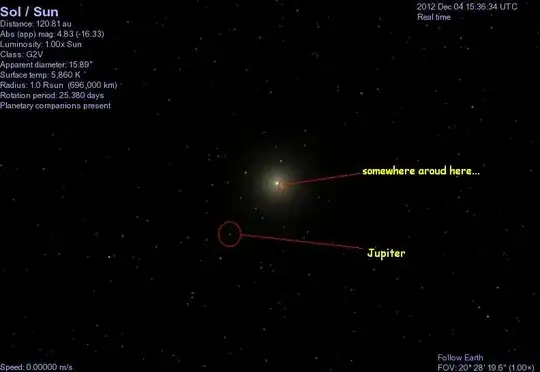Today Voyager 1 is approximately 122 AU distance from the Sun. What does the sun look like from this distance? How much brighter does the sun appear to the naked eye compared to other stars in the same field of view? Are any of the other planets from our solar system visible to the naked eye at this distance? Would the sun produce enough light for a normal person to read a book, or would the light be too dark for reading (just trying to get a practical feel of the amount of light)?
4 Answers
The sun would be similar in size as to many other fuzzy point-like stars in the sky. Its luminosity is pretty low at such a distance (about 122 Earth-sun distance). As Martin says, it is indeed a moon-light view.
This image is more or less similar to the 122 AU view. Thanks to Celestia (an amazing environment where I wonder about space) for this wonderful view. My travel through the solar system caught all the eight planets. The rock giants are not at all visible. But while clicking randomly around there somewhere, we could get the four planets. Jupiter is visible (like the other stars) at this distance (being somewhat big). It also pinpointed Saturn, Uranus & Neptune. But, we can't see any of them.

- 9,178
The Earth is 1AU from the sun (by definition!) so the sun is only 1/122 of the diameter in Voyagers sky. That means it would appear as large as stars appear to us on Earth by eye.
The light from the sun though spreads out with the area of the sphere, so the square of the distance. This means that at voyager it is only 1/(122*122) = 0.007% as bright. Thats about the same as moonlight compared to daylight.
All the other planets in the solar system are a lot closer to us than Voyager. Even the gas giants like Jupiter (5au) and Saturn (9au) would be visible as only faint stars.
Voyager took a famous photo of Earth (20 years ago, when it was only 40 Au away) - even with Voyager's telescope and sensitive camera it is just a pale blue dot
- 31,032
For a more perennial answer (as Voyager 1 is about 166 AU away in the year 2024, rather than 122), a formula to calculate the apparent magnitude of the sun based on distance is:
$$-26.832 + 5 \log_{10}\frac{d}{1\textrm{ AU}}$$
So back in 2012 when it was 122 AU away, the sun was mag -16.4, and in 2024 now it's at 166 AU, thus mag -15.7.
An illumination of 1 lux illumination is -14.2, and the full moon is -12.6. The latter is about the brightness of the sun at 700 AU, or 4 light-days. It's a shade under 1 light-day away currently, so very roughly it'll hit the sun-is-a-bright-as-the-moon point around 2175. Other apparent magnitudes are listed on Wikipedia to compare against.
- 861
The sun would still appear relatively bright from voyager. Given the apparent magnitude of -16.33, it is estimated to be around 25 times the maximum brightness of a Full moon from Earth (~-12.7).
Hence from voyager the sun would still be a bright pinpoint of light which can be discomforting to look at... The light at that brightness would be sufficient enough to read a book.
- 11